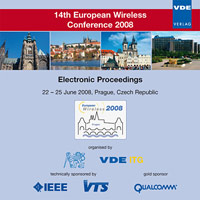Raising Coverage and Capacity using Fixed Relays in a Realistic Scenario
Konferenz: European Wireless 2008 - 14th European Wireless Conference
22.06.2008 - 25.06.2008 in Prague, Czech Republic
Tagungsband: European Wireless 2008
Seiten: 6Sprache: EnglischTyp: PDF
Persönliche VDE-Mitglieder erhalten auf diesen Artikel 10% Rabatt
Autoren:
Schoenen, Rainer; Zirwas, Wolfgang; Walke, Bernhard H. (NN)
Inhalt:
Multihop techniques are known as a practical solution for covering huge radio cell areas when there are only very few base stations (BS). This is the case when fiber access is limited and BS CAPEX and OPEX are very expensive. For WiMAX and 3GPP-LTE it is possible to operate relay stations which are only fed over the air link. While having some inherent overhead due to increased radio resource usage, there are nevertheless impressive gains in the coverage compared to a BS alone and also in the capacity of the whole radio cell. Near relay nodes (RN) there is not only better SINR to the user, which is obvious, but it is often more efficient to associate to a RN instead of the BS, taking into account all resources used for the first and second hop. Therefore this is a low cost measure to increase the system efficiency. This has been shown in the literature for artificial scenarios so far. In this paper we study a realistic scenario using data from topology information and raytracing. The city of Jersey was taken as example. The data is analyzed numerically, with all layer-1 and layer-2 performance models specified analytically. We study the case of one base station only, one BS with four RNs, and the latter plus another ring of nine RNs. The BS has fiber access, while the first hop of Relays (H1) is fed over the air from BS and the second hop H2 is fed by the RNs of group H1. We present results for the gains in coverage and capacity that are obtained by these Multihop techniques.


